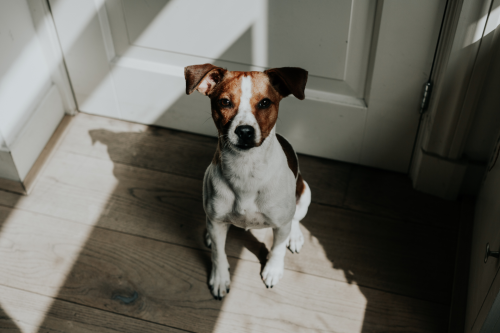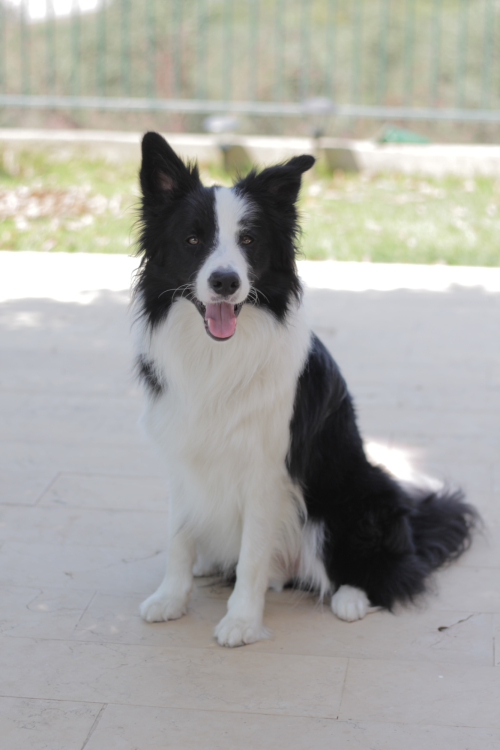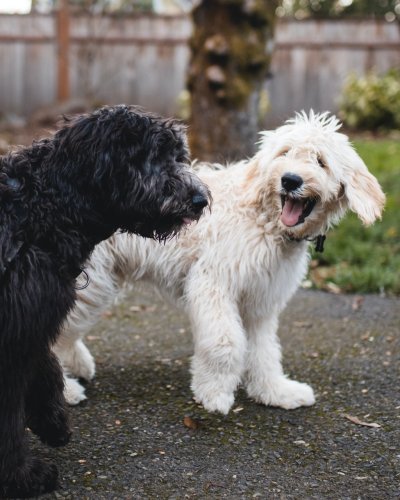Does my Dog sit weird? What you can do to help
Seeing or teaching a dog to sit is common practice. However, by analysing their sitting posture, we can discover hidden problems or gain clues about their physical health. Dogs sitting weirdly can be a sign of silent pain or health issues, so it’s essential to understand more about sitting posture, which we discuss in this article.
The Dog Sit
We all know it; we've seen it many times and possibly worked on getting our pet to do it on our command—the dog sit. It's probably one of the first behaviours that dogs learn when they are puppies, and it often seems to be one of the easiest to master.
It looks like this: a dog's bottom lowers to the ground, the hind limbs are bent and neatly tucked under the hips, the front legs stretched straight, and the head stands tall. Easy and simple. Or is it?
Many owners will mention that sometimes (or often) their dog sits weird—one leg sticking out, the spine looks arched, or both knees bent outward in an odd manner. Although these abnormal postures may be due to something benign such as fatigue after exercise or a developing body. More often than not, though, this might be one of the signs of a much bigger problem rather than simply an unusual choice of pose.
Does My Dog Sit Weirdly?
To answer this question, let's first learn to distinguish between good and bad dog sitting.
What's a Good Dog Sitting Position?

The dog has straight forelimbs when sitting properly, with elbows pointing backward and the shoulders down. The hind limbs are neatly tucked alongside the body, with the knees and toes facing forward. The head and neck are relaxed, looking forward.
An inability to adopt this posture can often happen during the puppy stage and in young dogs (up to two years old) whose skeletal and muscular structure is still developing. If we notice unusual sitting in adult dogs, it should attract our attention and prompt us to observe the frequency of such behaviour.
What Does Poor Posture in a Sit Look Like (a Sloppy Sit)?

Poor sit posture in the dog world has several names: lazy sit, sloppy sit, frog sit, or puppy sit. Precisely because of the latter, it is clear that puppies often demonstrate this behaviour. Puppies are very flexible since their boney structures are still developing, and their connective tissues are often more pliable than older dogs. Thus, movement patterns in younger dogs (including sitting) can look uncoordinated.
What does a sloppy sit look like? When viewed from the front, it may seem that the dog has thrown its hind legs to the side and is sitting on one hip only; from behind, it may look as if the spine is crooked to the side. The hind legs can be bent outwards at the knees (like a frog). However, due to the unnatural position of the spine, the shoulders may appear to stand high, and the forelimbs may not be aligned or pointed forward.
If your puppy adopts this sitting position only occasionally, it may be due to fatigue after exercise or a slight asymmetry during their developmental phase. However, if this positional dysfunction persists or is accompanied by other signs of movement dysfunction, then they should have a thorough physical assessment. Puppies or adult dogs that frequently sit weirdly or suddenly start sitting weirdly may have an underlying medical issue that requires intervention.
Why Is My Dog Sitting Weirdly?
There are various reasons why an adult dog might not have a perfect posture while sitting. Some are minor issues, easily treated by your canine manual therapist and precisely targeted exercises. While others may be the first sign of an underlying problem that dogs often try to cover up. Therefore, sloppy sitting in adult dogs should always be carefully observed to determine if a physical problem would require veterinary assistance.
Conformation
Sometimes the conformation of dogs is such that textbook-propper sitting makes them uncomfortable. Different types of dogs have different builds, and some prefer unique sitting positions precisely because of their conformation.
Long backs
An example of conformation affecting the dog's ability to sit can often be seen in dogs with long backs, such as the popular sausage dogs or dachshunds. This hunting breed is recognisable precisely by its elongated shape. Their long spine requires strong core muscles and a good range of motion through the hip, stifle and tarsal joints for them to successfully adopt the proper sitting form. Otherwise, they can be inclined to sit on their hip, with their feet off to one side.
Helping long-back dogs to maintain good posture throughout their lives is important in reducing the risk of long-term health consequences.

Dwarfism
Chondrodysplasia, also known as canine dwarfism, is a recessive genetic defect found in some purebred dog breeds. This condition occurs due to abnormal growth of cartilage, which affects the development of joints and the speed of their growth, resulting in irregular growth of limbs and the appearance of dwarfism. Probably the most famous dogs with this disorder are corgis, they physically are unable to point their forefeet forward. However, they will benefit, from regular conditioning to help support their bodies and maintain good posture.
Athletic Excellence
Certain types of dogs, such as sighthounds, are built for speedrunning and often have difficulty sitting correctly due to their long spines and strong muscular hindquarters. More specifically, these dogs have difficulty sitting in general as they often find it too uncomfortable to lower themselves into a sitting position, so most prefer the sphinx position or simply lying down.

Surfaces
If your dog is only showing signs of sitting weirdly in a particular place, consider that it could be down to the surface. Some dogs are picky about where they lower their bums, so a less-than-ideal surface might prompt them to avoid sitting directly on it—either because they've decided it's too wet, too hot, too cold, or perhaps too itchy.
Surfaces should always have enough grip that the dog can safely move into and out of the sit position without their feet slipping.
Fatigue
If your adult dog occasionally slips into a sloppy sit, it's not immediately a cause for concern. Sitting in the correct position requires core strength, which can be too much effort for a dog when it's tired after a long play session or exercise. Such issues are usually not too serious and resolve on their own.
Long training sessions for puppies, too, can result in this kind of behaviour. So keep in mind that they need to strengthen their muscles through conditioning exercises to withstand the challenges of sitting up straight after the training.
Dysfunctions
With all the above in mind, it is not an immediately alarming situation if you catch your adult dog in a strange sitting position on rare occasions.
However, if your dog is over two years old and sloppy sits very often, it would be a good idea to have it examined by a vet or therapist so that potential health problems that cause it can be detected in time. Judy C. Coates, a researcher and author of Evaluation and Rehabilitation Options for Orthopedic Disorders of the Pelvic Limb, highlights that, when observing the dog in the sitting posture, a therapist considers square sit as normal. Therefore, abnormal sitting posture is often a sign of an injury or pain. Some of the potential medical conditions that could cause weird sit are listed below.
Hip Dysplasia

Canine hip dysplasia appears more regularly in some breeds, with larger breeds often afflicted by this condition. Although, it is also not unusual for it to occur in small dogs. Hip dysplasia is caused by the ball and the hip joint socket not fitting correctly, so they rub and grind against each other when the dog moves. This causes pain because your dog may have difficulty walking, flexing their hip to climb stairs, or sitting correctly.
This condition is genetic, and the only thing you can do to reduce its occurrence is to get your dog from a reputable breeder who screens for hip dysplasia. Once diagnosed, hip dysplasia can be treated surgically, or the pain can be controlled with medication—something your vet will advise you best about. Manual therapy is an excellent adjunctive therapy for hip dysplasia, as it helps to maintain the range of motion in the joints and releases tension in soft tissue from muscle compensation.
Pain
A dog sitting in a position with its knees protruding outwards on each side can be a good indicator of pain. For example, a sloppy sit might be more convenient for your dog in this condition as it might help reduce tension in the already sore muscles.
Pain can present through other symptoms, too, such as lameness, unwillingness, or even aggression. If you think your dog is in pain, a quick thermal imaging scan can help identify areas of concern. From there, you can make a plan to treat your dog or seek a diagnosis and medical care from your veterinarian.
Injuries
If you notice that your dog is limping on its hind leg, that is, if it has problems with shifting its weight on one side, there may have been an injury that prevents your dog from sitting correctly. Injuries can be either internal or external and may affect bone, muscle, ligaments, tendons, nerves, or even the superficial layers of the skin. A qualified professional must assess injuries that prevent your dog from sitting.
Inflamed Anal Glands
Inflammation of the anal glands is an uncomfortable condition that can cause your dog to refuse to sit correctly, and they may prefer to lean to one side. You can learn more about inflamed anal glands in the previous article. What is certain is that if there is inflammation in your dog's anal glands, the dog will avoid putting pressure on this painful area at all costs and may show it through a sloppy sit.
Handler Impact

Sometimes a poor sitting posture results from the owner or trainers' biomechanics. When teaching a dog to sit, placement of the treat is essential in training good posture. Everyone wants their dog to learn quickly and to be motivated and engaged during training, but this requires the right approach. Improving the guide mechanics is one of the key things to work on. It doesn't need more training time but, rather, enhanced handler mechanics.
Mechanics include your handling (position, movement, leash), timing, cues, and delivery of reinforcements (prepare treats in advance). The handler's body language must be neutral when teaching a new behaviour, and it is necessary to reward (reinforce) only the behaviour we want from the dog.
If we give confusing commands to the dog, be that verbal or through the position of our body, this may force the dog into a poor sitting pose. Regular reinforcement of poor posture will likely increase the frequency with which the dog adopts the dysfunctional pose.
How to Correct Your Dog's Sit
Now that we have talked about several possible reasons that cause dogs to sit weirdly, it's time to approach your dog individually and observe if this is a common behaviour or if it only occasionally shows a sloppy sit. For example, is your dog a puppy that doesn't yet know how to sit correctly? Do you notice any other symptoms that might indicate painful conditions?
Perhaps changing the surface you usually train on will show that this was the reason for the sloppy sit all along. Also, could you consider from which side you observe the dog and in which position you are concerning the dog when you notice a weird sit?
To help your dog strengthen its physical condition, in addition to regular exercises, you can provide your dog with quality supplements. Antinol is a dietary supplement that reduces inflammation and promotes joint function and health, which will facilitate holding the proper posture.
Where physical dysfunction is the reason for the incorrect sitting, you should contact a professional that can help your dogs, such as a veterinarian or a canine therapist, depending on the severity and type of condition.
Dogs lacking in muscular strength or condition, without other concerns, can be booked in for an online consult with a canine fitness trainer. These professionals can help you improve your dog's sitting biomechanics.





Leave a comment